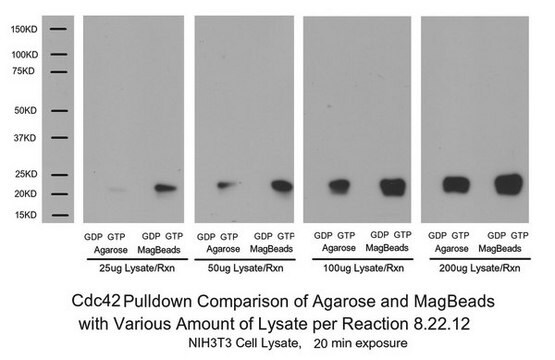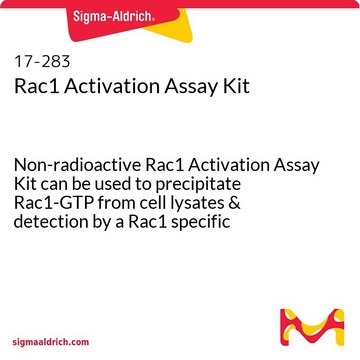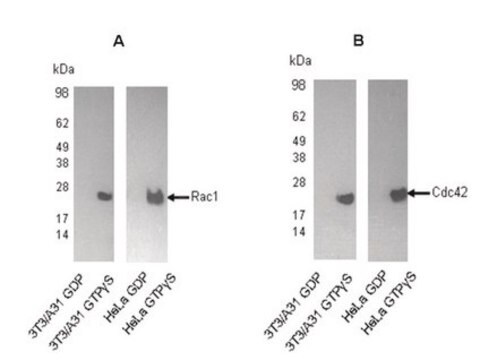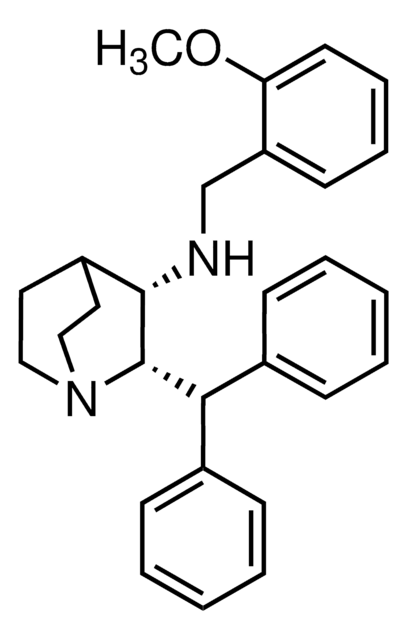17-10393
Rac1 Activation Magnetic Beads Pulldown Assay
Non-radioactive Rac1 Activation Assay Kit can be used to precipitate Rac1-GTP from cell lysates, & detection by a Rac1 specific monoclonal antibody.
About This Item
Recommended Products
Quality Level
species reactivity
rat, mouse, human
manufacturer/tradename
Upstate®
technique(s)
activity assay: suitable (G-protein activation)
affinity binding assay: suitable
NCBI accession no.
UniProt accession no.
shipped in
dry ice
Gene Information
human ... RAC1(5879)
Specificity
Anti-Rac1, clone 23A8 (mouse monoclonal IgG2b): Human, mouse and rat, other species cross-reactivity unknown. Note: This antibody may be reused 3-5 times for immunoblot analysis. Add 0.05% sodium azide to the blocking buffer containing the diluted antibody. Do not use sodium azides with HRP
Application
Signaling
Packaging
Components
Anti-Rac1, clone 23A8: (Part No. 05-389) One vial containing 250 ug of purified IgG2akappa in 250 uL of storage buffer (0.1 M Tris-glycine, pH 7.4, 0.15 M NaCl, containing 0.05% sodium azide).
Mg2+ Lysis/Wash Buffer, 5X, (Part No. 20-168).Two vials, each vial contains 18 mL of 125 mM, HEPES, pH 7.5, 750 mM NaCl, 5% Igepal CA-630, 50mM MgCl2, 5 mM EDTA and 10% glycerol
100X GTPγS, 10mM (Cat.# 20-176) One vial containing 50 uL of 10 mM GTPγS, 100X stock, in sterile water. Non-hydrolyzable analog of GTP. Sufficient to label 5 mL of cell lysates
100X GDP, 100 mM, (Part No. 20-177). One vial containing 50 uL of 100 mM GDP, 100X stock, in sterile water. GDP, Guanosine 5’-Diphosphate, type I, for in vitro labeling of G-proteins in the inactive form. Sufficient to label 5ml of cell lysates.
Quality
Linkage
Legal Information
Disclaimer
Signal Word
Danger
Hazard Statements
Precautionary Statements
Hazard Classifications
Aquatic Acute 1 - Aquatic Chronic 2 - Eye Dam. 1
Storage Class Code
10 - Combustible liquids
Regulatory Listings
Regulatory Listings are mainly provided for chemical products. Only limited information can be provided here for non-chemical products. No entry means none of the components are listed. It is the user’s obligation to ensure the safe and legal use of the product.
PDSCL
Please refer to KIT Component information
PRTR
Please refer to KIT Component information
FSL
Please refer to KIT Component information
ISHL Indicated Name
Please refer to KIT Component information
ISHL Notified Names
Please refer to KIT Component information
Cartagena Act
Please refer to KIT Component information
JAN Code
キットコンポーネントの情報を参照してください
Certificates of Analysis (COA)
Search for Certificates of Analysis (COA) by entering the products Lot/Batch Number. Lot and Batch Numbers can be found on a product’s label following the words ‘Lot’ or ‘Batch’.
Already Own This Product?
Find documentation for the products that you have recently purchased in the Document Library.
Our team of scientists has experience in all areas of research including Life Science, Material Science, Chemical Synthesis, Chromatography, Analytical and many others.
Contact Technical Service










